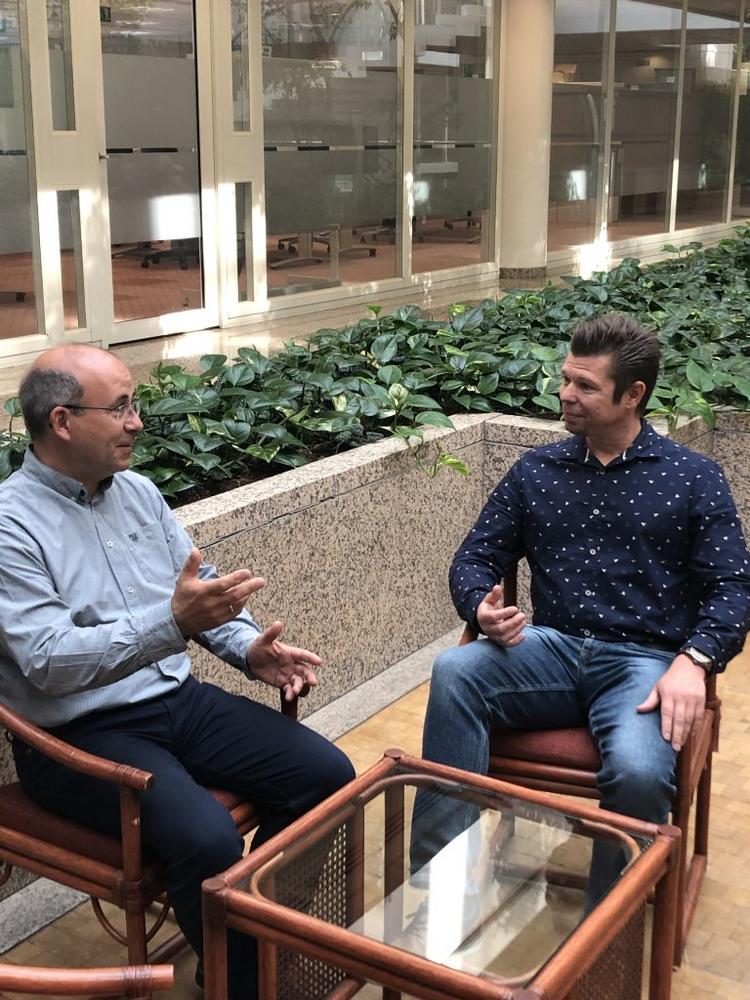Enterprise Architect facilitates communication
In the development process of the enterprise architecture, the modelling platform finds its main use as a tool in the collaboration of the various stakeholders in the development and approval process. Jimmy Cams, head of Enterprise Architecture at KBC: "We have to have our architecture models agreed and approved in different board meetings. This works very well with the models in Enterprise Architect, as we can show each stakeholder the views that are important for the decision."
Hans Bartmann, Managing Director of SparxSystems Central Europe, comments: "KBC is an excellent example of how Enterprise Architect supports the diverse communication around the creation of an enterprise architecture. After all, models offer many advantages for all parties involved, from a common language and approach to seamless documentation. We are therefore very pleased that KBC can use Enterprise Architect to better ground and accelerate its decisions."
The KBC metamodel as a basis
For Alain Garsoux, the KBC metamodel is the basis for better decisions: "Only the metamodel enables us to define a common language and a uniform modelling approach. This means that once things have been worked out, they can be used again and again, and decision-making speeds up." A metamodel is a higher-level model used to formalize other model concepts. It models the concepts of usable model elements and their interrelationships. The KBC metamodel is based on the ArchiMate and TOGAF standards. It contains "stereotypes" organized in layers like context, business, application, information and infrastructure. To speed up the delivery of architectural diagrams, instances of most stereotypes are uploaded from the production environment.
Critical success factor: the people modelling
At KBC, around 20 architects are currently working with the architecture meta model, and in addition to Enterprise Architect, Pro Cloud Server (Integration) is also in use. Roll-out plan is ongoing and all modelling around KBC will be done with the same language and the same tool to ensure persistent documentation and its reuse. The target audience for modelling is a community of 60-80 architects. For Jimmy Cams, the people are the most important success factor of all: "We have to keep a constant eye on a few key points in our team: competences and skills, availability, motivation, role clarity." For this purpose, training and coaching are offered for the handling of the architecture practice. The solution has been embedded in the organization via a community of practice. Architects own the solution and a governance model is in place in order to integrate new ideas.
Clear and lightweight processes
To achieve a clearly defined and lightweight process, clear guidelines have been defined. For example, each specific use case is modelled at the solution level and relevant stereotypes are transferred to enterprise levels. Restrictions were also deliberately decided on the standard views and reports available for the different stakeholders. Initially, only four views were created to support decision-making and compliance: Diagrams for processes, application interfaces, applications and technologies. These are to be provided with clear instructions and are to be created with as little effort as possible. Alain Garsoux concludes: "It has been very successful to limit ourselves to the most important areas when developing the enterprise architecture. This way we do not get bogged down and can quickly provide the basis for well-founded decisions while ensuring value for the organization. We will have more room for desirable extensions in the future once we have succeeded in creating a firm basis for the architecture."
About KBC
KBC Group NV was formed in 1998 through the merger of two Belgian banks and an insurance company. With approximately 40,000 employees worldwide, around 12 million clients are served through the integrated bank-insurance business.
KBC sees itself as a group of more than 40,000 talented employees in different countries who work together and share a common culture.
This culture is the fertile and stimulating ground on which the strategy is built, which consists of four cornerstones that interact with each other:
– We strive to provide our customers with a unique banking and insurance experience.
– We develop our Group with a long-term perspective, achieving sustainable and profitable growth
– We put our clients‘ interests at the heart of everything we do and strive to provide them with quality service and relevant solutions at all times
– We take our responsibility towards society and the local economy very seriously and aim to reflect this in our daily actions
Sparx Systems Pty Ltd (Australia) was founded in 1996 and is the manufacturer of Enterprise Architect, a globally successful UML modeling platform. Enterprise Architect is used to design and build software systems, to model business processes and to model any process or system. Enterprise Architect in its current version 16 is valued by over 850,000 users for its performance at an unbeatable price. Enterprise Architect is an easy-to-understand, team-oriented modeling environment that supports companies in the analysis, design and creation of precisely traceable and documented systems. With the help of this tool, companies are enabled to centrally collect and display the often very distributed knowledge of teams and departments.
In order to offer the best service around Enterprise Architect to the numerous customers in their language and time zone, SparxSystems Software Central Europe was created in 2004, which supports the entire German-speaking region in the acquisition of licenses as well as through training and consulting. SparxSystems Software Central Europe is a business unit of Lieber.Group.
www.sparxsystems.eu
Sparx Systems Europe
Gumpendorfer Strasse 19
A1060 Wien
Telefon: +43 (1) 8900899
http://www.sparxsystems.de
Leitung Presse- und Öffentlichkeitsarbeit
Telefon: +43 (1) 9072627-204
E-Mail: Ruediger.Maier@4biz.at
![]()
